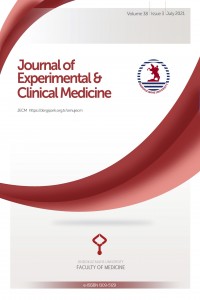Abstract
Introduction and Objective: Pilonidal sinus, especially in young males, is one of the most common diseases of the sacrococcygeal region. Although many surgical techniques have been described for pilonidal sinus disease (PSH), high recurrence rates and patient satisfaction are still controversial with regard to the ideal treatment modality. In this study, we aimed to compare the complications in Primary excision, Limberg flap, elliptical rotation flap and karydakis techniques used in patients with pilonidal sinus disease.
Method: The patients who were diagnosed with Pilonidal sinus and underwent surgery between January 2012 and January 2017 were retrospectively analysed from our hospital database. Patients in whom the Primary repair, Limberg flap, elliptical rotation flap and karydakis flap repair performed were divided into four groups. The groups were compared in terms of their demographic characteristics, length of hospitalization, seroma formation, surgical site infections, wound dehiscence, flap necrosis, sensory loss and recurrence.
Results: There were 107 patients in the primary group, 70 in the Limberg flap group, 72 in the elliptical rotation flap group and 45 in the karydakis flap group. There was a statistically significant difference between the groups in terms of the length of hospitalization (p < 0.001). The maximum length of hospitalization period was observed in the Limberg group and was 2.06 ± 0.95 days. The minimum duration of hospitalization was 1.00 ± 0.00 days in the karydakis group. Wound site infection was observed mostly in the primary group with 15% frequency, whereas this higher ratio was significant when compared with Elliptical Rotation flap and Karydakis flap groups (p = 0.010, 0.024 respectively). There was no statistically significant difference between the groups in terms of wound dehiscence, flap necrosis, sensory loss and recurrence (add p values respectively).
References
- 1. [1] Okuş A, Karahan Ö, Eryılma MA ve ark. Pilonidal Hastalığın Toplumda Görülme Sıklığı, Yaşa ve Cinsiyete Göre Dağılımı (Erken Sonuçlarımız). Selçuk Tıp Derg 2013; 29(3): 120-122.
- 2. [2] Sondenaa K,AndersenE, Nesvik I, Søreide JA. Patient characteristics and symptoms in chronic pilonidal sinus disease. Int J Colorectal Dis 1995;10(1) :39-42.
- 3. [3] Humphries AE, Duncan JE.Evaluation and management of pilonidal disease. Surg Clin North Am. 2010;90:113-24.
- 4. [4] DumanK, Gırgın M,HarlakA. Prevalence of sacrococcygeal pilonidal disease in Turkey. Asian J Surg.2016; 04: 1-4.
- 5. [5] Mentes O, Bagci M,BilginT, Ozgul O, Ozdemir M. Limberg flap procedure for pilonidal sinus disease: results of 353 patients. Langenbecks Arch Surg. 2008;393:185-9.
- 6. [6] Uçar AD, Cartı EB, Oymacı E, Sarı E, Yakan S, Yıldırım M, Erkan N. Recurrent pilonidal disease surgery: Is it second primary or reoperative surgery? Ulus Cerrahi Derg. 2015 1;32:162–7.
- 7. [7] Vedder N.B. Flap physiology. Mathes Plastic Surgery, 2nd edition. Philadelphia: Saunders Elsevier Inc, Vol:1;483–506, 2006.
- 8. [8] ArslanS, KaradenizE, Ozturk G, Aydinli B, Bayraktutan MC, Atamanalp SS. Modified Primary Closure Method for the Treatment of Pilonidal Sinus. Eurasian J Med. 2016 ; 48:84–9.
- 9. [9] Polat C, Gungor B, Karagul S, Buyukakincak S, Topgul K, Erzurumlu K. Is oval flap reconstruction a good modification for treating pilonidal sinuses? Am J Surg. 2011 ; 201:192.
- 10. [10]Ocakoğlu A, Ünal E. The Comparison Of Lay-Open, Karydakis Flap And Limberg Flap Techniques In Pilonidal Sinus Surgery. Haydarpaşa Numune Eğitim ve Araştırma Hastanesi Tıp Dergisi. 2012; 52(2): 74-78.
- 11. [11] Karydakis GE. New approach to the problem of pilonidal sinus. Lancet 1973; 22: 1414-5.
Abstract
References
- 1. [1] Okuş A, Karahan Ö, Eryılma MA ve ark. Pilonidal Hastalığın Toplumda Görülme Sıklığı, Yaşa ve Cinsiyete Göre Dağılımı (Erken Sonuçlarımız). Selçuk Tıp Derg 2013; 29(3): 120-122.
- 2. [2] Sondenaa K,AndersenE, Nesvik I, Søreide JA. Patient characteristics and symptoms in chronic pilonidal sinus disease. Int J Colorectal Dis 1995;10(1) :39-42.
- 3. [3] Humphries AE, Duncan JE.Evaluation and management of pilonidal disease. Surg Clin North Am. 2010;90:113-24.
- 4. [4] DumanK, Gırgın M,HarlakA. Prevalence of sacrococcygeal pilonidal disease in Turkey. Asian J Surg.2016; 04: 1-4.
- 5. [5] Mentes O, Bagci M,BilginT, Ozgul O, Ozdemir M. Limberg flap procedure for pilonidal sinus disease: results of 353 patients. Langenbecks Arch Surg. 2008;393:185-9.
- 6. [6] Uçar AD, Cartı EB, Oymacı E, Sarı E, Yakan S, Yıldırım M, Erkan N. Recurrent pilonidal disease surgery: Is it second primary or reoperative surgery? Ulus Cerrahi Derg. 2015 1;32:162–7.
- 7. [7] Vedder N.B. Flap physiology. Mathes Plastic Surgery, 2nd edition. Philadelphia: Saunders Elsevier Inc, Vol:1;483–506, 2006.
- 8. [8] ArslanS, KaradenizE, Ozturk G, Aydinli B, Bayraktutan MC, Atamanalp SS. Modified Primary Closure Method for the Treatment of Pilonidal Sinus. Eurasian J Med. 2016 ; 48:84–9.
- 9. [9] Polat C, Gungor B, Karagul S, Buyukakincak S, Topgul K, Erzurumlu K. Is oval flap reconstruction a good modification for treating pilonidal sinuses? Am J Surg. 2011 ; 201:192.
- 10. [10]Ocakoğlu A, Ünal E. The Comparison Of Lay-Open, Karydakis Flap And Limberg Flap Techniques In Pilonidal Sinus Surgery. Haydarpaşa Numune Eğitim ve Araştırma Hastanesi Tıp Dergisi. 2012; 52(2): 74-78.
- 11. [11] Karydakis GE. New approach to the problem of pilonidal sinus. Lancet 1973; 22: 1414-5.
Details
| Primary Language | English |
|---|---|
| Subjects | Health Care Administration |
| Journal Section | Clinical Research |
| Authors | |
| Publication Date | May 1, 2021 |
| Submission Date | December 16, 2020 |
| Acceptance Date | February 6, 2021 |
| Published in Issue | Year 2021 Volume: 38 Issue: 3 |
Cite

This work is licensed under a Creative Commons Attribution-NonCommercial 4.0 International License.


